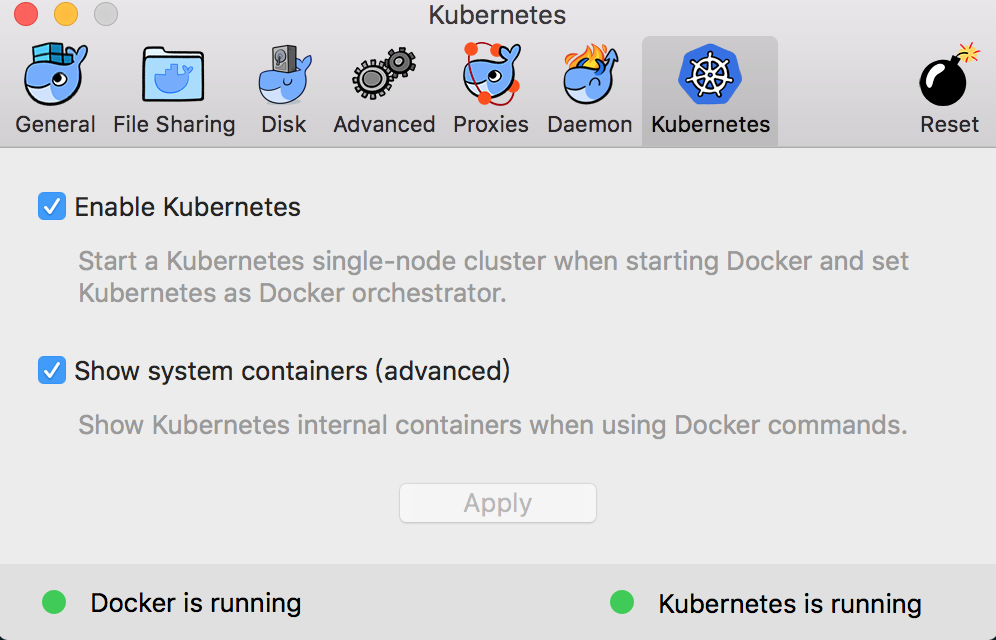

This allows for a number of useful arrangements, like using multiple processes to deal with processing batch jobs, shipping logs or metrics, or a process called "initContainers" that runs once to help set up the 'Pod' for operation.

A Pod is one or more containers running in a logical group. This running instance is actually in an object called a 'Pod'. When you create a deployment in Kubernetes, the number of replicas you want is set in the manifest, each replica is a copy of the containers that are in the spec. If the "STATUS" field says "Running" it's working as expected. Confirm it's running by looking at the resulting pod that's running, kubectl get pods. You should see output that looks like the following: NAME READY STATUS RESTARTS AGEĮxample1-7466b89f7c-cs4cc 1/1 Running 0 14s This will deploy the nginx docker container and run it as a process on the cluster. kubectl apply -f manifests/1_helloworld_deploy.yaml Write this into a yaml file, or use the file from the Github repository, and use the kubectl command to apply the workload definition. So, to set up something on the cluster we need to write a yaml file to describe what we want to run.Īll the manifests for this example deployment can be found in the repository under the manifests folder.įirst, let's describe a workload deployment: apiVersion: apps/v1 Kubernetes describes all workloads through a simple yaml format file called a "manifest". In this example, we'll run a simple webserver with a "hello world" message of our own creation. Now that the cluster is up and running, we can run a process. It only takes a few minutes, and after this runs you should see a friendly message telling you your cluster is ready.Īs the output says, the cluster is up and your kubectl command configuration is already set to talk to the cluster. kind create cluster -name mycluster -config config/ -wait 5m The extra port mapping is required to allow us to talk to the webserver we will run later on. If you have any, you can stop them all at once using: docker stop $(docker ps -a -q)įirst, we need a little configuration to prepare our new Kubernetes node. If you have other containers running on your system, it's best to stop them as they may conflict with the ports used in this example.ĭocker ps will show you any containers that are running already. Kind deploys a Kubernetes instance in a Docker container. Once all these components are installed, you're ready to create your local Kubernetes cluster.
Docker for mac kubernetes local image install#
or use the Chocolatey package manager for Windows: choco install kindįor full up to date instructions on any of these kind installation methods, see the projects Quick Start Guide. \kind-windows-amd64.exe c:\some-dir-in-your-PATH\kind.exe With Windows, either use curl if you have it available. On a Mac, alternatively it can be installed easily using the brew command again, with: brew install kind On Linux or Mac you can install it from the Github releases page, much like the kubectl binary, with these commands: curl -L -o kind KINDįinally, you will need to get the kind command. On Windows, of course, instructions are also available on the Kubernetes kubectl installation instructions page. Further instructions for MacOs are available in Kubernetes MacOs kubectl installation instructions. On a Mac, it should be easy if you use the brew package manager by running brew install kubectl. But it can be installed easily by using the following commands: curl -LO `curl -s ` /bin/linux/amd64/kubectl On Linux, kubectl install instructions are available, including methods to install it, with your Linux distributions' packages manager. You will also need the kubectl command to interact with the cluster once it's up and running. On Mac or Windows, use the instructions for your platform from Docker's documentation. On Linux it's best to use your operating system package manager, apt on ubuntu or debian, yum or dnf on Fedora/Centos/RHEL and pacman or yay on Archlinux. To get kind working, you need to have Docker installed. To make things easier for yourself, you can clone the examples within the tutorial in our public git repository: Kubernetes Hello World. Setting up a local Kubernetes cluster is incredibly simple these days, thanks to the wide availability of tools like Minikube, Mikrok8s, Kind etc… Throughout this tutorial we’ll use kind because it’s the fastest to set up with minimal dependencies, as long as you are able to run Docker on your machine. Either way, this step-by-step guide will walk you through setting up a Kubernetes cluster on your own computer and deploy a simple application into the cluster. Maybe you’ve heard of Kubernetes but haven’t explored it any further or you’ve done a bit of research but have yet to test the waters of what it can do.


 0 kommentar(er)
0 kommentar(er)
